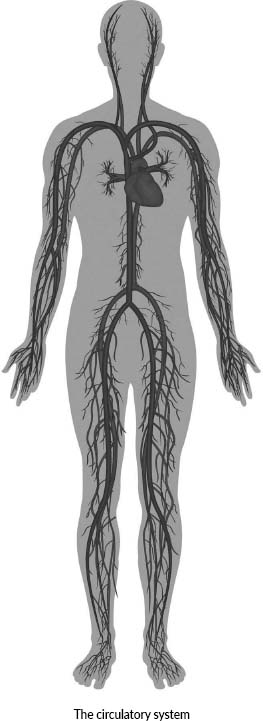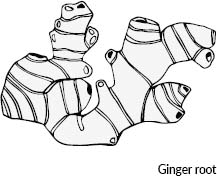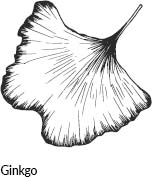

“Nature, time, and patience are the three greatest physicians.”
—Irish Proverb
The heart and circulatory system are concerned with carrying various nutrients and oxygen to and from different parts of the body via the bloodstream, and this vital transport system also removes waste product from every cell. It is important that we look after the heart and circulation with a wholesome diet and the use of appropriate herbal remedies that have an affinity with this system. Common conditions that affect circulation are chilblains, poor blood flow to the hands and feet, blood pressure, high cholesterol levels, and varicose veins. Many people suffer from poor circulation, and looking after our cardiovascular system should be a health priority.
The lymphatic system is intimately connected with the circulatory system, but unlike blood circulation it does not have a pump (a heart), so slow-moving lymph fluid needs to be kept in motion in order to remove cellular debris if the body is to stay healthy. Exercise and massage are recommended to keep lymphatic structures moving, and we will discuss this further in chapter 10.
I have already mentioned garlic's immune supporting benefits. Allicin is one of the most powerful active principals of garlic. It protects the heart, and this versatile herb's other therapeutic property ajoene, which is also a heart protector. Allicin, as it breaks down its by-products, is believed to interact with a body chemical that regulates blood clotting, helping to keep this mechanism balanced. Garlic protects blood vessels, keeping them healthy into old age, and it also has cholesterol lowering abilities, making it a valuable aid to keeping the heart healthy. Due to its artery-dilating properties, garlic can also help lower blood pressure. Researchers discovered that eating garlic is cardio-protective, something herbalists have known since the early part of the 20th century.

When we ingest garlic, allicin breaks down into sulphur compounds, which react with red blood cells and produce hydrogen sulphide. This relaxes blood vessels, keeping blood flowing easily. Research on garlic was carried out by the University of Alabama, Birmingham, and it appeared in Proceedings of the National Academy of Sciences; meanwhile as far back as 1982, The British Medical Journal endorsed garlic's properties in lowering cholesterol and reducing blood pressure by dilating blood vessels.
Garlic has so many benefits that go a long way to helping avoid heart attacks and strokes, and it would be wise to take some garlic as a preventative on a regular basis. The primary goal of herbalism is to strengthen the person's own bodily functions before disease sets in; using herbs is a prophylactic (a preventative).
Fresh garlic cloves are available from supermarkets, and tablets, capsules, and tinctures are available in health stores.
This herb with its warming qualities is one of nature's most valued plants. Used in Chinese and Ayurvedic medicine for thousands of years, we find its use in records dating from the 4th century BC. Ginger's fiery, stimulating properties can help bring warmth to the whole body, stimulating sluggish blood circulation, and supporting healthy heart function. Ginger warms up peripheral circulation, improving cold hands and feet, and is good to use if you suffer from chilblains. This aromatic spice also helps support the maintenance of healthy blood pressure and cholesterol levels. This finding is supported by a study published in the New England Journal of Medicine, which found that ginger helps reduce cholesterol. It can also help lower blood pressure and prevent blood clots that trigger heart attacks and strokes.

Ginger adds zest to herbal teas and taken with some honey can help stave off winter chills. Traditional Chinese herbalists use this yang herb to stimulate sweating through the skin and to stimulate the heart. They also recommend a course of ginger throughout the winter to warm up body energies during the cold and damp season. You can make infusions from fresh root, or buy capsules, tinctures, and ginger tea.
One of the world's oldest living species of tree, ginkgo biloba has spread its protective branches over the earth for three thousand years. It was believed that this sacred tree of Asia protected Japanese and Chinese temples from evil spirits, while gingko's health-related properties were recognized by ancient Traditional Chinese herbalists. The roots and bark contain beneficial flavonoids.
In the West, ginkgo has become popular and is used to improve circulation to all parts of the body. Because of its blood-moving abilities, it is beneficial for use by people who suffer from cold hands and feet. Ginkgo strengthens and opens up blood vessels. Traditional herbalists recommend ginkgo to help move stagnant energy. After a heart attack, ginkgo helps repair damaged blood vessels and tissues. Ginkgo can be taken as a brain food to improve blood flow to the brain, helping to boost concentration and to slow dementia that comes with old age. It also has a positive effect on mental performance, and it protects aging brains by supporting brain function and improving memory. Problems with tinnitus, an inner ear condition that can sometimes also be age-related, has also been helped with the use of this herb. Extracts of ginkgo biloba are available as tinctures, capsules, tablets and teas.

Capsicum, commonly known as cayenne pepper, was used by ancient herbalists to treat the “King's evil” or scrofula. This small perennial shrub originated from the tropical areas of South America, and today this kitchen spice is used to flavor food—for those who can stand the heat! It was the great standby of traditional herbalists, who used it when dealing with cholera. Medicinally, this warming herb promotes a healthy circulatory system due to its active properties, imparting warmth to a number of body functions. Exerting a beneficial effect on the cardiovascular system, it invigorates the blood and helps remove toxins, substances that undermine health. Cayenne improves circulation, and helps open up body tissues, improving blood flow, which is why traditional herbalists consider cayenne a good blood mover. Cayenne acts as a catalyst, breaking down food and aiding its absorption; it also improves lung resistance against cold and damp. A good circulatory tonic to use when this system needs a boost. It is available in capsules or tinctures from health stores. Capsicum combines well with garlic.
Hawthorn is a common hedgerow shrub that is known as the May blossom tree. In Pagan traditions, hawthorn was used in fertility rites and was a symbol of both life and death. The hawthorn tree flowered on May Day and was used to decorate the maypole.
This warming herb's red haw berries contain valuable flavonoids and tannins that are attributed to improving peripheral circulation, regulating the heart rate and blood pressure. Rich in vitamins C and B-complex, hawthorn has diuretic properties and is good for minor angina (although hawthorn should never replace a prescription for nitro-glycerin tablets). The main medicinal properties of this plant are its tonic flavonoids, which help prevent coronary artery disease. This wayside herb has been used by traditional herbalists as a restorative and strengthener for various heart problems. Hawthorn normalizes and strengthens the contractions of the cardiac muscle, and it is a valued natural medicine used as a heart tonic due to its invigorating action on this vital organ. It is available as a tea, in tablets, capsules, or as tinctures.